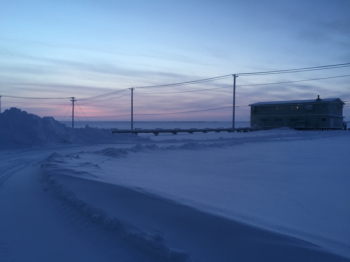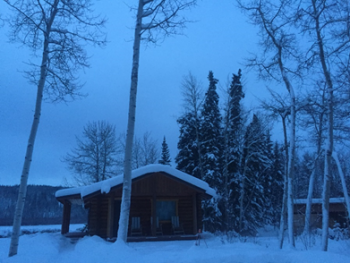Lessons for Energy-Efficient Homes in Cold Climates

For many Alaska Natives, arctic and circumpolar climates present unique building science challenges for maintaining a dry, warm, and energy-efficient home.
In Utqiaġvik, Alaska (formerly known as Barrow)—the northernmost point of the United States—temperatures of 20-below-zero and colder are very common and wind chills can exceed -148°F. Compare that to Cordova—the southern region of Alaska—where a typical day in the cold season is temperate and wet, ranging from 28-47°F and totaling nearly 100 inches of snow every year.
“Build tight, ventilate right” is Jack Hébert’s building design philosophy, from cold and dry to wet and windy regions. With over 40 years of experience building homes in Alaska and deep roots in the culture, Hébert understands quality, environmentally appropriate, and energy-efficient building design for cold climates—and he shared his knowledge with the U.S. Department of Energy’s (DOE) Office of Indian Energy Policy and Programs in a recent webinar.
Hébert is founder of the Cold Climate Housing Research Center (CCHRC), which recently joined forces with DOE's National Renewable Energy Laboratory in Golden, Colorado. “Build tight, ventilate right is a simple but effective principle that provides a comfortable, durable, and stable living environment and lowers energy bills,” he said.
Start with the Building Envelope
The exterior walls of a home are the largest surface area exposed to the elements, and therefore the most vulnerable to energy losses. If a wall system isn’t functioning properly, it can be the culprit for up to 30% of the total energy losses in a home.
If a caribou doesn’t have a well-designed parka, no matter how much food it eats or energy it produces, the animal can’t survive. A home functions the same way.
When it’s cold outside, warm moist air from inside tries to escape any way possible, whether that’s around windows and doors, gaps in the roof, or small holes in the walls vapor barrier. When this warm moist air or vapor hits an extremely cold surface, it condenses into frost or water that can stay until springtime, when the walls are finally able to dry out. Over time, this moisture accumulation can lead to structural deterioration, a very common problem in cold-climate homes.
There are many ways to construct an energy-efficient wall that is also durable and addresses the moisture problem.
In temperate climates, most homes solve the moisture problem with a vapor barrier applied to the inside of the wall, against the insulation layer. This isn’t as effective in cold climates, though, where inside moisture always manages to find its way into the wall and hits the very cold outside surface.
One solution used by CCHRC is to move the majority of the insulation to the outside of the wall framing. The REMOTE wall, for example, uses a thick layer of foam board outside the wall to keep the wall framing warm and dry. This protection acts as a parka for a home and keeps the vapor barrier warm, so any moisture that escapes doesn’t turn to water.
In addition to insulating walls, caulking windows, using triple-pane windows, and blown-in cellulose in the attic and roof can seal up other air leaks, or tears in the parka.

Home in on Heating
Heat is vital to living in artic and circumpolar regions and accounts for 80% of energy used in a typical building or home. There are many options for heating systems that can help reduce heating costs and incorporate clean and alternative energy systems into homes.
With advanced technology, air-source heat pumps have become good options for cold climates, whereas traditionally, they’ve only been used in temperate climates. DOE estimates annual savings with air-source heat pumps of 3,000 kWh (or $459) for cold climates.
An air-source heat pump uses electricity and acts like a reverse refrigerator by taking heat from outdoor air and transferring it to a home. Fluid travels through coils of pipe, heats up, and evaporates into gas, which is then compressed until it is hot enough for space heating. It then passes through coils and transfers heat to the indoor air, which is moved throughout the room with a fan.
A ground-source heat pump is another energy-efficient heating system that can perform well in cold climates, even when the ground is very cold. These systems are efficient because they source heat from the ground, using electricity to increase the temperature further for space heating. These systems can produce much more heat than the small amount of electricity used to operate them.
Don’t Forget to Address Ventilation & Air Quality
Indoor air quality is one of the biggest challenges in cold climates. Because homes are typically built tightly to preserve heat and minimize cold drafts, there is very little natural ventilation. While this helps a home be thermally efficient, it does not create high-quality indoor air or a healthy living environment.
Without ventilation, humidity increases, which increases the risk of mold, mildew, or bacteria in the air. Alaska has the highest incidence of upper respiratory distress of elders and children in the United States due to mold, mildew, and bacteria within the homes.
Saving energy can’t be at the expense of the health or comfort of the people living in the home. You can’t separate the shelter from the people, so we always need to take a holistic design approach and consider the effect a building has on a family.
Alaska buildings require special mechanical systems for ventilation and to preserve heat, while also moving stale air out of the building. Heat-recovery ventilators are efficient, effective options for doing that as they combine heating and ventilation in a single system and use the heat from stale exhaust air to pre-heat incoming fresh air.
According to DOE’s Energy Saver program for consumers, a heat-recovery ventilation system can recover up to 80 percent of heat energy that would exhausted, or otherwise wasted. “Heat-recovery systems ensure warm, comfortable air without driving up electric costs,” Hébert said.
Visit the CCHRC website to learn more about their innovative buildings design and research.
Learn more about energy efficiency from DOE’s Energy Saver program, and read about the Office of Indian Energy’s support for Alaska Natives.
